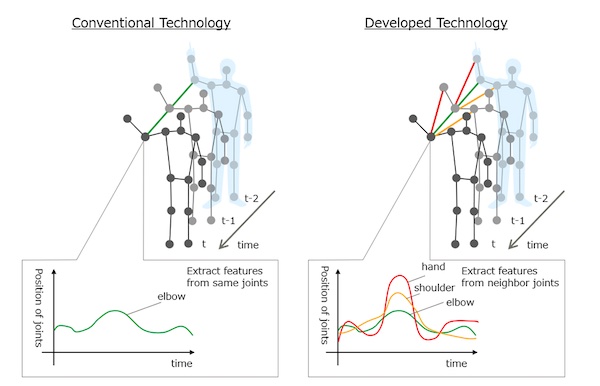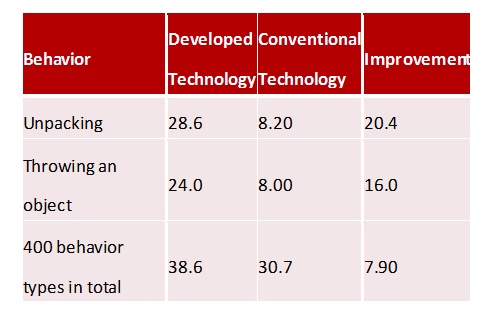|
| Wednesday, 13 January 2021, 09:55 HKT/SGT | |
| |  | |
Source: Fujitsu Ltd | |
|
|
|
TOKYO, Jan 13, 2021 - (JCN Newswire) - Fujitsu Laboratories Ltd. has announced the development of a technology that utilizes deep learning to recognize the positions and connections of adjacent joints in complex movements or behavior in which multiple joints move in tandem. This makes it possible to achieve greater accuracy in recognizing, for instance, when a person performs a task like removing objects from a box. This technology successfully achieved the world's highest accuracy(1) against the world standard benchmark(2) in the field of behavior recognition, with significant gains over the results achieved using conventional technologies, which don't make use of information on neighboring joints.
 | | Fig. 1 Outline of the newly developed technology compared with conventional technologies |
 | | Fig. 2 Improvement of accuracy with new technology |
By leveraging this technology to perform checks of manufacturing procedures or unsafe behavior in public spaces, Fujitsu aims to contribute to significant improvements in public safety and in the work place, helping to deliver on the promise of a safer and more secure society for all.
Fujitsu will present the details of this technology at the 25th International Conference on Pattern Recognition (ICPR 2020), which is being held online from January 10th, 2021 (Sunday) to January 15th, 2021 (Friday).
Background
In recent years, advances in AI technology have made it possible to recognize human behavior from video images using deep learning. This technology offers a variety of promising applications in a wide range of real-world scenarios, for example, in performing checks of manufacturing procedures in factories or detecting unsafe behavior in public spaces. In general, human behavior recognition utilizing AI relies on temporal changes in the position of each of the skeletal joints, including in the hands, elbows, and shoulders, as identifying features, which are then linked to simple movement patterns such as standing or sitting.
With time series behavior-recognition technology developed by Fujitsu Labs, Fujitsu has successfully realized highly-accurate image recognition using a deep learning model that can operate with high-accuracy even for complex behaviors in which multiple joints change in conjunction with each other, such as removing objects from a box during unpacking.
About the Newly Developed Technology
Complex movements like unpacking involve hand, elbow, and shoulder joints moving in tandem with the arm bending and stretching. Fujitsu has developed a new AI model for a graph convolutional neural networks(3) that performs convolution operation of the graph structure by adopting a graph consisting of edges connecting adjacent joints based on the structure of the human body with the joint position as a node (Vertex). By training this model in advance using the time series data of joints, the connection strength (Weight) with neighboring joints can be optimized, and effective connection relationships for behavior recognition can be acquired. With conventional technologies, it was necessary to accurately grasp the individual characteristics of each joint. With an AI model that has already been trained, the combined features of the adjacent joints that are linked can be extracted, making it possible to achieve highly-accurate recognition for complex movements.
This technology was evaluated against the world standard benchmark in the field of behavior recognition using skeleton data, and in the case of simple behaviors such as standing and sitting in the open data set, the accuracy rate was maintained at the same level as that of conventional technology(4) that does not use information on neighboring joints. In the case of complex behaviors like a person unpacking a box or throwing an object, however, the accuracy rate improved greatly, to achieve an overall improvement of more than 7% over the conventional alternative to reach the world's highest recognition accuracy.
Future Plans
By adding the newly developed AI model for recognizing complex behaviors obtained with this technology to the 100 basic behavior already accommodated by Fujitsu's behavioral analysis technology "Actlyzer,"(5), it will become possible rapidly deploy new, highly-accurate recognition models. Fujitsu ultimately aims to leverage this new capability to roll out the system in fiscal year 2021, and contribute to the resolution of real-world issues to deliver a safer and more secure society.
(1) World's highest accuracy: As of January 13th, 2021. In the Kinetics-Skeleton category.
(2) World standard benchmark: Kinetics-Skeleton dataset benchmarks.
(3) graph convolutional neural networks: Deep neural network for convolutional operation on graph structure.
(4) Same level as that of conventional technology
Using the Kinetics-Skeleton dataset released by Chinese University of Hong Kong, an evaluation was made with the technology released by the same university in 2018. The correct answer rate is the rate at which the predicted result matches the correct answer.
(5) Behavioral analysis technology "Actlyzer"
Deep learning technology that can recognize a variety of subtle and complex human movements without relying on large amounts of training data. (Press Release: 2019/11/25)
About Fujitsu
Fujitsu is the leading Japanese information and communication technology (ICT) company offering a full range of technology products, solutions and services. Approximately 130,000 Fujitsu people support customers in more than 100 countries. We use our experience and the power of ICT to shape the future of society with our customers. Fujitsu Limited (TSE:6702) reported consolidated revenues of 3.9 trillion yen (US$35 billion) for the fiscal year ended March 31, 2020. For more information, please see www.fujitsu.com.
About Fujitsu Laboratories
Founded in 1968 as a wholly owned subsidiary of Fujitsu Limited, Fujitsu Laboratories Ltd. is one of the premier research centers in the world. With a global network of laboratories in Japan, China, the United States and Europe, the organization conducts a wide range of basic and applied research in the areas of Next-generation Services, Computer Servers, Networks, Electronic Devices and Advanced Materials. For more information, please see: http://www.fujitsu.com/jp/group/labs/en/.
Topic: Press release summary
Source: Fujitsu Ltd
Sectors: Enterprise IT
http://www.acnnewswire.com
From the Asia Corporate News Network
Copyright © 2025 ACN Newswire. All rights reserved. A division of Asia Corporate News Network.
|
|
|

|
|
|
|
| Fujitsu Ltd |
| Dec 4, 2025 18:08 HKT/SGT |
|
Fujitsu and Scaleway partner to accelerate European sustainable transformation and data sovereignty with FUJITSU-MONAKA CPU-based AI inference |
| Dec 2, 2025 22:26 HKT/SGT |
|
Fujitsu develops new technology to support human-robot collaboration |
| Dec 2, 2025 21:55 HKT/SGT |
|
Fujitsu establishes international consortium to tackle disinformation/misinformation and new AI risks |
| Dec 1, 2025 22:04 HKT/SGT |
|
Fujitsu achieves high-precision, long-duration molecular dynamics simulation for all-solid-state battery interphases with over 100,000 atoms |
| Dec 1, 2025 21:43 HKT/SGT |
|
Fujitsu develops multi-AI agent collaboration technology to optimize supply chains, launches joint trials |
| Dec 1, 2025 21:14 HKT/SGT |
|
Fujitsu launches 'Fujitsu Accelerator Program for SPORTS' to create new value through Sports x Technology |
| Nov 28, 2025 17:01 HKT/SGT |
|
Fujitsu builds platform for NSK to create environmental value throughout the product lifecycle of bearing products |
| Nov 28, 2025 16:28 HKT/SGT |
|
Fujitsu launches Japan Edition of SAP Fioneer Cloud for Insurance, a next-generation platform supporting core business operations in the Japanese insurance industry |
| Nov 27, 2025 21:00 HKT/SGT |
|
Fujitsu and Yamaguchi University develop low-power edge computing technology for near real-time image processing on small satellites |
| Nov 26, 2025 18:05 HKT/SGT |
|
Fujitsu accelerates blue carbon certification with ocean digital twin technology |
| More news >> |
 |
|
 |
|